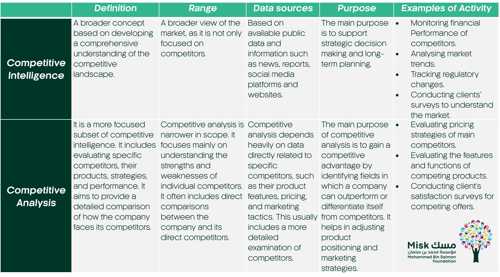In this article, we will learn about Competitive Intelligence (CI), its importance, its types, and its methods for collecting information, as well as how it differs from Competitive Analysis.
What is Competitive Intelligence?
Competitive Intelligence (CI), or Corporate Intelligence, refers to the ability of companies to collect information about competitors, market trends, customers, and business environments and analyse this information in a practical, systematic, and ethical manner. This information is then used to make decisions and obtain competitive advantage, higher market share, and increase in revenue.
The Importance of Competitive Intelligence?
CI is of great importance to companies that want to lead the competition and understand the market and the industry trends. The following points illustrate its importance:
- Helping Companies Make Strategic Decisions: CI enables companies to understand opportunities, challenges, strengths, and weaknesses, and adapt to market changes to make calculated and effective strategic decisions for growth.
- Risk Reduction: CI helps in identifying potential or anticipated risks and market weaknesses by keeping track of competitors' actions. This proactive knowledge enables companies to respond to these challenges faster than the rest of their competitors.
- Market Expansion: CI provides valuable insights into local markets, competitors, and client and consumer preferences. It also helps companies get an understanding of regulatory environments. Through these benefits, CI enables companies to enter new markets successfully and efficiently.
- Innovation in Product Development:CI can contribute to the design of innovative products that meet the needs of clients and consumers in the market. By understanding and analysing competitors' offers and clients’ feedback, startups can discover their strengths and weaknesses and therefore develop and improve their products competitively.
- Effective Marketing: CI helps startups to understand the marketing strategies followed by competitors and selecting websites, platforms, and messages, which in turn help in creating more powerful and effective marketing campaigns. Through CI, startups can discover gaps in their marketing processes and exploit them effectively.
Types of Competitive Intelligence?
CI includes different types or categories, each serving a specific purpose in helping companies gain insight into their competitors and market trends. Here are the top four main types of CI:
- Tactical or Short-Term Competitive Intelligence:
This type of CI focuses on daily activities and short-term decision-making. It includes monitoring competitors’ movements in real time, tracking price changes, and launching products and marketing campaigns. It also enables companies to respond immediately to competitive actions.
- Strategic or Long-Term Competitive Intelligence:
Strategic CI depends on long-term understanding and focuses on the overall situation and the future direction of both the company and its competitors. It includes analysing market trends, industry changes, emerging technologies, and competitors’ strategies to make strategic decisions.
- Product Competitive Intelligence:
Product CI is based on the understanding of the competitive scene related to products or services. It includes research, pricing, quality, and client feedback features to guide the product development, pricing strategies, and product positioning.
- Technological Competitive Intelligence:
Technological CI includes tracking emerging technologies and innovations in a specific industry or field. It helps startups identify opportunities for technological advancements, partnerships, or acquisitions that can give them a competitive advantage.
5 Ways to Gather Information in Competitive Intelligence?
In order to be able to analyse and use information about competitors and market trends, you must first know the ethical and legal methods for this process, which include the following:
- General information: It includes the general sources available to learn more about competitors, such as their website, social media platforms, press releases, and others that can be accessed in an ethical and legal manner.
- Competitor analysis tools: Various software tools and platforms are available to track and analyse competitors’ data, including their online presence, keyword rankings, and social media engagement, such as SEMrush, Ahrefs, Moz Pro, SimilarWeb.
- Surveys and interviews: Conducting surveys and interviews with experts in the sector or industry, as well as with clients, consumers, and former employees of competitors, can lead to acquiring valuable insights and data.
- Trade shows and conferences: Exhibitions and conferences provide good opportunities for companies to communicate with competitors, monitor their products and latest developments, and gather information about the market.
- Competitive measurement: It means comparing the company's performance with the performance of competitors by using Key Performance Indicators (KPIs) to identify strengths and weaknesses and take advantage of this information to obtain a competitive advantage.
The Difference between Competitive Intelligence and Competitive Analysis:

Finally, in the current information age, CI is the basis that connects companies to their markets, clients, and competitors. It is also a strategic tool that allows companies to plan their tracks with confidence, progress towards success and development, and seize opportunities accurately.

